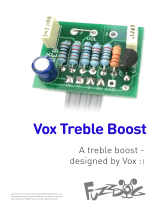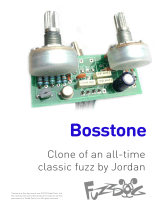Page is loading ...

EMpathy Drive
MkII of the awesomely simple
OD/Boost with clipping options
Contents of this document are ©2015 Pedal Parts Ltd.
No reproduction permitted without the express written
permission of Pedal Parts Ltd. All rights reserved.

PCB Layout ©2015 Pedal Parts Ltd.
Schematic + BOM
R1 2M
R2 4K7
R3 1M*
R4 2k2 (CLR)
C1 100n**
C2 100n**
Q1 2N5088
GAIN 250KB
VOL 250KA
*R3 is an optional anti-pop resistor -
Best to put it in to avoid nasty noise
when engaging the circuit.
**The caps could be increased if you
want lower frequencies to get through
there, or decreased if you want to cut
some bass.
S1 and D1-4 are clipping mods.
See overleaf.

There’s room on the back of the PCB for large paper-in-oil caps. These are
marked C3-C4. C3 connects directly to the same pads as C1, C4 to C2.
Use EITHER C1-2 or C3-4, not both.
You’ll notice there are extra pads next to C1 and C2. These allow easy use of
bigger caps than standard 5mm pitch. If using them, make sure one leg of
your cap goes into the pad nearest the side of the board, then the other leg
can go in any of the other three pads at the other end of the cap space. If you
look at the board layout on the previous page, the pads marked in blue all
connect together at one end of C1, ditto the red ones and C2.
Big Fat Mojo Caps

It’s really simple to add clipping options to the circuit. You have two pairs of
clipping diodes. You can use either pair, both, or none.
They’re paired up as D1-2 and D3-4. Put in whatever your choice of diodes is.
Here at FDHQ we’ve tried 1N34A and 1N4148. Didn’t really see the need to
look any further as they both gave great results.
Your switching options are:
•If using one set of diodes, use a SPDT ON-ON to choose between stock
(no clipping) and clipped.
•If using two sets of diodes, use a SPDT ON-OFF-ON to choose between
clipped 1, stock (no clipping) and clipped 2
•Maybe you want two clipping options and no stock unclipped options.
Just put in both pairs of diodes and use a SPDT ON-ON.
You can mount a micro toggle
switch straight to the PCB. It can go
on either face, depending on how
far away from the pots you want it
to be. If you’re using PIO caps it has
to go on the same side as the other
components and the pots.
If you want to wire up a standard
switch just connect the lugs of the
switch to the S1-1,2,3 pads. Pad 2
to middle lug.
Clipping Mods

Test the board!
UNDER NO CIRCUMSTANCES will troubleshooting help
be offered if you have skipped this stage. No exceptions.
Once you’ve finished the circuit it makes sense to test is before starting on
the switch and LED wiring. It’ll cut down troubleshooting time in the long
run. If the circuit works at this stage, but it doesn’t once you wire up the
switch - guess what? You’ve probably made a mistake with the switch.
Solder some nice, long lengths of wire to the board connections for 9V, GND,
IN and OUT. Connect IN and OUT to the jacks as shown. Connect all the
GNDs together (twist them up and add a small amount of solder to tack it).
Connect the battery + lead to the 9V wire, same method. Plug in. Go!
If it works, crack on and do your switch wiring. If not... aw man.
At least you know the problem is with the circuit. Find out why, get it
working, THEN worry about the switch etc.
UO
YRET
T
A
AT
B
NI
TU
GND
9V
IN
S
T
UDING WIRED PO
INCL
cuit boa
w cir
e, ne
our nic
Y
o
NI
OUT
!!!!
d
ar
TUO

(if using a daughterboard please refer to the relevant document)
Wire it up - with battery
This circuit is standard, Negative GND. Your power supply should be
Tip Negative / Sleeve Positive. That’s the same as your standard pedals (Boss etc),
and you can safely daisy-chain your supply to this pedal.
The BOARD GND connections don’t all have to connect to one point. They can be
daisy-chained around the circuit, using larger connection points (such as jack socket
lugs) for multiple connections. As long as they all connect together in some way.
L
E
D
BOARD
OUT
BOARD
9V
BOARD
GND
BOARD
GND
BOARD
GND
BOARD
INPUT
BATTERY
+
IN
OUT
L
E
D
BOARD
GND
BOARD
LED+
+

(if using a daughterboard please refer to the relevant document)
Wire it up - DC only version
L
E
D
BOARD
OUT
BOARD
9V
BOARD
GND
BOARD
GND
BOARD
GND
BOARD
INPUT
+
IN
OUT
L
E
D
BOARD
GND
BOARD
LED+
This circuit is standard, Negative GND. Your power supply should be
Tip Negative / Sleeve Positive. That’s the same as your standard pedals (Boss etc),
and you can safely daisy-chain your supply to this pedal.
The BOARD GND connections don’t all have to connect to one point. They can be
daisy-chained around the circuit, using larger connection points (such as jack socket
lugs) for multiple connections. As long as they all connect together in some way.

Drilling template
Micro-Toggle Switch
Hammond 1590B
60 x 111 x 31mm
Recommended drill sizes:
Pots 7mm
Jacks 10mm
Footswitch 12mm
DC Socket 12mm
Micro-Toggle 5mm
Blue hole is for micro toggleswitch mounted
same side of the pcb as the pots.
Green for opposite side.
This template is a rough guide only. You should ensure correct marking of your
enclosure before drilling. You use this template at your own risk.
Pedal Parts Ltd can accept no responsibility for incorrect drilling of enclosures.
32mm
19mm
8mm
It’s a good idea to drill
the holes for the pots
8mm to give yourself
some wiggle room unless
you’re a drill ninja

Drilling template
Standard Switch
Hammond 1590B
60 x 111 x 31mm
Recommended drill sizes:
Pots 7mm
Jacks 10mm
Footswitch 12mm
DC Socket 12mm
Standard Toggle Switch 6mm
Green hole is for normal toggle switch position.
If using a normal switch along with large PIO
capacitors you need to put the switch above the
pots in the blue position.
This template is a rough guide only. You should ensure correct marking of your
enclosure before drilling. You use this template at your own risk.
Pedal Parts Ltd can accept no responsibility for incorrect drilling of enclosures.
PedalParts.co.uk
32mm
21mm
6mm
It’s a good idea to drill
the holes for the pots
8mm to give yourself
some wiggle room unless
you’re a drill ninja
/









